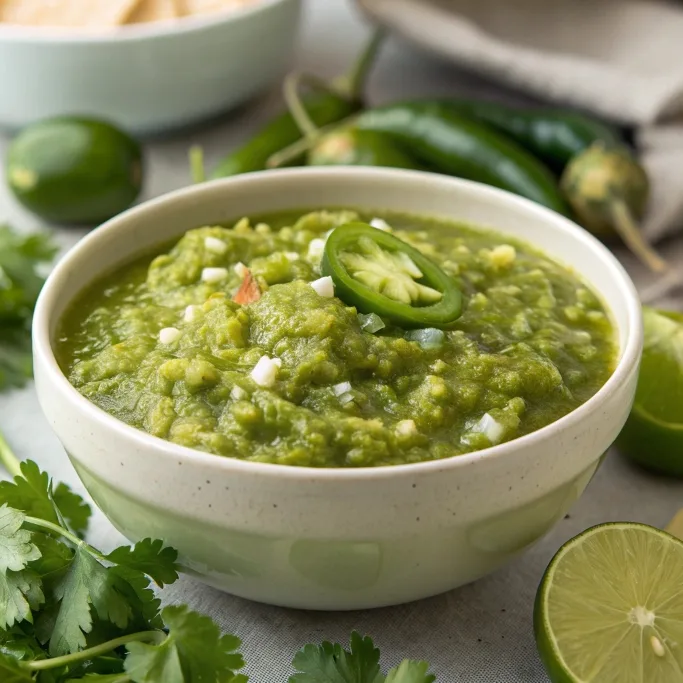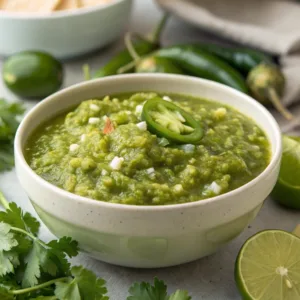
Few condiments bring as much brightness and depth of flavor to the table as a well prepared salsa verde. The beauty of this sauce lies in its ability to be mild, zesty, or fiery depending on the ingredients you choose. When Emilie Trindade pinned her favorite easy salsa verde recipe on Food! in 2025, it highlighted a trend that shows no sign of slowing down. Mexican salsa recipes have always been central to family cooking and entertaining, and today they continue to inspire home cooks to try their own variations. This article will walk you through creating the best green salsa recipe at home, using fresh and simple ingredients that transform ordinary meals into something extraordinary.
Why Salsa Verde is Special
Salsa verde is more than a sauce. It is a cultural icon in Mexican cuisine, a staple that can be found on every family table. Its combination of tomatillos, green peppers, and herbs creates a refreshing yet tangy taste that pairs beautifully with tacos, enchiladas, grilled meats, and chips. While red salsas often get the spotlight, fresh salsa verde recipe offers a milder yet equally vibrant option for those who want complexity without overwhelming heat. Many consider it the homemade green sauce that goes with everything, from breakfast eggs to roasted vegetables.
Ingredients for Authentic Salsa Verde
- 1 pound tomatillos, husked and rinsed
- 2 fresh green peppers (jalapeño or serrano for heat, poblano for mildness)
- 1 medium white onion, peeled and quartered
- 3 garlic cloves, unpeeled
- 1 cup fresh cilantro leaves
- 1 lime, juiced
- 1 teaspoon salt
- Optional: avocado for creaminess
This combination creates the foundation for a fresh green salsa recipe. Adjust the ratio of peppers depending on whether you prefer a fiery sauce or a mild salsa verde that is family friendly.
Step by Step Instructions
Step 1: Roast the Vegetables
Place the tomatillos, green peppers, onion, and garlic on a baking sheet. Roast under a broiler until the skins begin to char, about 6 to 8 minutes. This step deepens the flavor and adds a slightly smoky character to the fresh green salsa. Alternatively, you can dry roast them in a hot skillet until blistered.
Step 2: Blend the Ingredients
Once roasted, peel the garlic and place all vegetables into a blender or food processor. Add cilantro, lime juice, and salt. Blend until smooth or pulse for a chunkier texture, depending on your preference. Some prefer their green taco salsa thick and rustic, while others like it silky and pourable.
Step 3: Adjust and Taste
Taste the salsa and adjust with more lime juice or salt if needed. If you want extra heat, blend in additional roasted peppers. For a creamier version, add a ripe avocado and blend again, creating a luscious variation of homemade green sauce.
Step 4: Chill and Serve
Let the salsa rest in the refrigerator for at least 30 minutes. This allows the flavors to meld beautifully. Once ready, serve with chips, drizzle over tacos, or spoon onto enchiladas for a dish that feels vibrant and authentic.
Serving Ideas for Salsa Verde
One of the most versatile sauces, salsa verde adapts to countless dishes. Here are a few ideas:
- Green salsa for enchiladas: Pour over rolled tortillas filled with chicken or cheese for a comforting Mexican classic.
- Green taco salsa: Add a spoonful to carne asada tacos or grilled fish tacos for brightness.
- Serve with scrambled eggs or huevos rancheros for a zesty breakfast option.
- Use as a dip for tortilla chips or drizzle over nachos.
Why You’ll Love This Recipe
- Simple and quick preparation that takes less than 20 minutes.
- Customizable heat level: choose mild peppers for mild salsa verde or add more serranos for spice.
- Versatile: perfect as a green salsa for enchiladas, dipping sauce, or topping for tacos.
- Nutritious and fresh: packed with vitamin rich tomatillos, garlic, and herbs.
- Budget friendly: most ingredients are inexpensive and easy to find year round.
Cultural Note
In Mexican cuisine, salsa verde has deep roots, dating back to the Aztecs who relied on tomatillos as a staple. Over time, it has become a universal condiment across Latin America, with regional twists. Some areas favor roasted peppers, others prefer raw ingredients for a brighter taste. No matter the version, the core identity of salsa verde remains the same: a vibrant, refreshing sauce that reflects the heart of Mexican cooking.
Pro Tips for Perfect Salsa Verde
- Always roast the vegetables for deeper flavor, even if you prefer a fresh salsa verde recipe.
- Use fresh lime juice, not bottled, for the best tangy kick.
- Chill before serving to help the flavors blend fully.
- If too spicy, add avocado or extra roasted tomatillos to mellow the heat.
- For a brighter color, blend in raw cilantro after roasting other ingredients.
Storage and Reheating
Store your salsa verde in a sealed container in the refrigerator for up to five days. For longer storage, freeze in small portions and thaw as needed. While salsa verde does not require reheating, you can gently warm it in a skillet if you want to serve it with hot enchiladas or tamales. Be careful not to overheat, as it can dull the fresh flavor.
Common Mistakes to Avoid
- Using unripe tomatillos without roasting can lead to a sour flavor.
- Adding too much lime juice at once. Start small and build gradually.
- Skipping the roasting step, which is key to achieving the best green salsa recipe.
- Not tasting and adjusting salt before serving.
Frequently Asked Questions
Can I make salsa verde without tomatillos?
Tomatillos are essential for authentic flavor, but you can substitute green tomatoes in a pinch. The result will be a fresh green salsa with a slightly different taste.
Is salsa verde always spicy?
No. You can create a mild salsa verde by using poblano peppers or removing seeds from spicier peppers. The recipe is easily adjusted for your heat preference.
Can I use salsa verde for more than tacos?
Absolutely. It works beautifully as green salsa for enchiladas, topping for grilled chicken, or as a dipping sauce for vegetables and chips.
What is the difference between salsa verde and guacamole?
Salsa verde focuses on tomatillos and peppers, while guacamole is based on avocados. Some people combine them, blending avocado into salsa verde to create a creamy homemade green sauce.
Closing Thoughts
Whether you discovered this recipe through a Pin by Emilie Trindade on Food! in 2025 or from your love of Mexican salsa recipes, making salsa verde at home is a rewarding experience. It connects you to tradition, invites creativity, and delivers a sauce that elevates any meal. Keep this guide handy, and soon you will have your own version of the best green salsa recipe that friends and family will ask for again and again.
If you loved this article, share it with fellow food lovers and don’t forget to comment below with your favorite way to enjoy salsa verde.
Easy Salsa Verde Recipe
Equipment
- Baking Sheet
- Blender or Food Processor
- Knife
Ingredients
Base Ingredients
- 1 lb tomatillos husks removed, rinsed
- 2 green peppers jalapeño or serrano for heat, poblano for mildness
- 1 medium white onion peeled and quartered
- 3 cloves garlic unpeeled
- 1 cup fresh cilantro leaves
- 1 lime juiced
- 1 tsp salt
- avocado optional, for creaminess
Instructions
- Place tomatillos, peppers, onion, and garlic on a baking sheet. Roast under a broiler for 6–8 minutes until charred, or dry roast in a skillet until blistered.
- Peel garlic and transfer all roasted vegetables to a blender or food processor. Add cilantro, lime juice, and salt. Blend until smooth or pulse for a chunkier salsa.
- Taste and adjust seasoning. Add more lime juice or roasted peppers as desired. For creaminess, blend in avocado.
- Refrigerate for at least 20–30 minutes before serving to allow flavors to meld.

